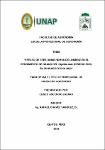Efecto de tres dosis humus de lombriz en el rendimiento de grano del Glycine max (Hibrido 5909) en Zungarococha 2022
Abstract
Cultivating of soya (5909) he/she settled in the investigation Shop Agrostologico the purpose it was to determine if the worm humus used in several dose has effect in its yield, the design was experimental of quantitative type, the participants 480 soya plants distributed in 12 beds with 40 plant c/u, you sampling at random, the DBCA was used with 4 methods and 3 reproductions and the test of Tukey, being concluded: In the plant height the best result is of the T3 (5 kg/m2 of humus) with 51.3 cm, followed by the T2 (4 kg/m2 of humus) with 47.7 cm and in last position the T0 (2 payment kg/m2) with 45 cm, in number of sheaths the T3 also sample better results with a stocking of 41 vainas/planta, in second order the T2 with 38 sheaths, in third and quarter position the treatments (T1 and T0 with values of 38 and 37 sheaths respectively). In the weight of grains for plant the T3 also presents an average of (60 g/planta), to a density of siembra of 0.50 x 0.50 would have (40000 planta/ha) which would report a yield of grain of 2 400 kg/hectárea, in second place, the T2 with a stocking of (52 g/pta = 2 080 kg/ha), the T1 with an average of (44.7 g/plta = 1 788 kg/ha) and the T0 with (35.3 g/pta = 1 412 kg/ha). For what the supposed hypothesis is accepted. El cultivar de soya (5909) se instaló en el Taller de Investigación Agrostologico, la finalidad fue determinar si el humus de lombriz utilizado en varias dosis tiene efecto en su rendimiento, el diseño fue experimental de tipo cuantitativo, los participantes 480 plantas de soya distribuidas en 12 camas con 40 plantas c/u, se muestreo al azar, se utilizó el DBCA con 4 métodos y 3 reproducciones y la prueba de Tukey, concluyéndose: en la altura de planta el mejor resultado es del T3 (5 kg/m2 de humus) con 51.3 cm, seguido del T2 (4 kg/m2 de humus) con 47.7 cm y en último puesto el T0 (2 kg/m2 de abono) con 45 cm, en número de vainas el T3 también muestra mejores resultados con una media de 41 vainas/planta, en segundo orden el T2 con 38 vainas, en tercero y cuarto puesto los tratamientos (T1 y T0 con valores de 38 y 37 vainas respectivamente). En el peso de granos por planta también el T3 presentó un promedio de (60 g/planta), a una densidad de siembra de 0.50 x 0.50 tendríamos (40000 planta/ha) el cual reportaría un rendimiento de grano de 2 400 kg/hectárea, en segundo lugar, el T2 con una media de (52 g/pta = 2 080 kg/ha), el T1 con un promedio de (44.7 g/plta = 1 788 kg/ha) y el T0 con (35.3 g/pta = 1 412 kg/ha). Por lo que la hipótesis supuesta es aceptada.
Collections
- Tesis [670]


